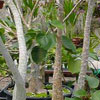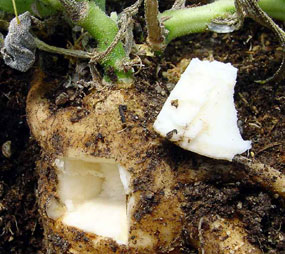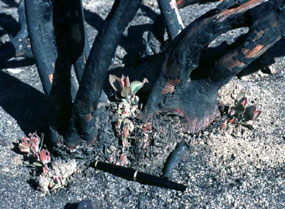Definition of a Succulent
Mark Dimmitt, Director of Natural History
Arizona-Sonora Desert Museum
Classifying plants as succulent or nonsucculent is problematic. Regional floras
and popular books on succulents are all vague at defining what makes a plant
a succulent. For example, Rowley (1978) concluded only that many plants are difficult
to categorize as to succulence. Popular publications on succulents often ignore
clearly succulent plants such as many orchids and bromeliads simply because most
succulent collectors don't grow them (e.g., Eggli 2001). Plant physiologists
and systematists tend to be similarly noncommittal. Some authors use the term
semisucculent for those plants with less obvious succulent characteristics, but
this still leaves the separation between semisucculent and nonsucculent undefined.
Von Willert et al. (1992) represents the only source we know of that attempts
a concise description. They define a succulent as any plant that possesses a
succulent tissue, and further specified a succulent tissue as "... a living tissue
that... serves and guarantees a ...temporary storage of utilizable water, which
makes the plant... temporarily independent from external water supply...". The
authors recognized a subcategory of xerophytic succulents, which excludes halophytic
succulents (salt-tolerant plants that often grow in saline wetlands) and most
geophytes (plants with their perennating organs below ground, e.g., potato, Jatropha
macrorhiza, and most plants that are colloquially called "bulbs" in
horticulture). 
Examples of bulbous geophytes.
(The Freesia is technically a corm; the others are true bulbs.) The fleshy parts of most "bulbs"
serve more for food storage than water storage; they produce above-ground
growth only after the soil is moistened. However, some bulbous geophytes
sprout before the beginning of the rainy season or maintain green foliage
well into the dry season; we would classify these as succulents. The
succulent tissues of halophytes and of most geophytes serve functions
other than to support growth when soil moisture is unavailable. This
definition of the term xerophytic succulent still leaves the status
of a number of plants in question.
Some questionably succulent species
(click on images for additional information and more photos)
|

matacandelilla, giant
cane milkweed
Asclepias albicans |

tescalama, rock fig
Ficus palmeri |
|

torote prieto
Bursera hindsiana
|

ocotillo macho
Fouquieria macdougalii |
|

calabacilla, coyote
gourds
Cucurbita spp.
|

matacora
Jatropha cuneata
|
|

liga
Euphorbia xantii
|

mistletoe
Psittacanthus sonorae |
We classify all of the above except Psittacanthus as succulents;
this parasite is rather fleshy, but it has a dependable supply of water as long
as its host is alive.
Calabacilla and many other cucurbits have large tuberous roots that have
considerable moisture as well as copious starch reserves. A sample of
Cucurbita foetidissima root was 81% water. They produce leafy shoots,
flowers, and fruits well in advance of seasonal rains. This trait is itself
insufficient to separate calabacilla from clearly nonsucculent plants
such as manzanita (Arctostaphylos spp.), which sprout from woody
crowns immediately after dry-season fires. Metabolizing stored starch
in manzanita crowns and roots generates enough water to support growth
in the fall before the winter rains begin. Though tuberous-rooted cucurbits
may also produce some of their water from starch breakdown, the high free
water content along with their ability to produce growth even after a
year without rain leads us to classify them as xerophytic root succulents.
 |
 |
| Cucurbita foetidissima root
with section cut out to show succulent tissue |
Manzanita (Arctostaphylos sp.)
sprouting from the root crown 2 months after a fire |
The growthform of tescalama (desert rock fig, Ficus petiolaris palmeri) is intermediate
between a woody tree and a stem succulent. The fact that seedlings can
establish on exposed rock faces (saxicole) in the desert indicates that
this species has adaptations that typical woody trees lack. The caudex
of a young tescalama contained 68% water, somewhat more than stems of nonsucculent
trees such as foothill palo verde (Parkinsonia microphylla, 53%
water). Tescalama does not appear to have CAM. We tentatively classify
it as a succulent based on its marginally elevated water content and
lifestyle. (A closely related species, F. petiolaris petiolaris, occurs
in tropical deciduous forest, a community comprised of so many similarly
semisucculent trees of numerous species that the forest cannot support
a fire.)
 |
 |
 |
| Ficus palmeri (rock fig), in cultivation |
Parkinsonia microphylla (foothill palo
verde) |
Ficus petiolaris (rock fig) |
Most species of Fouquieria exhibit a woody
shrub growthform, albeit a strange one. But they have a clearly succulent lifestyle: very
shallow roots and the capacity to produce functioning leaves within
2 days after a light rainfall (ca. 7 mm). The thin subcutaneous layer
of moist tissue in these plants is succulent in nature (Henrickson,
1969a and b, 1972). The rapid leaf production indicates the presence
of an undescribed non-CAM idling metabolism (Dimmitt
2000).
 |
 |
 |
Fouquieria on a sand dune with shallow roots exposed by
wind erosion |
Fouquieria leaves, 2 days after a rain |
The broken spine reveals a subcutaneous layer of moist
tissue |
REFERENCES
Dimmitt, Mark A. 2000. Flowering plants of the Sonoran Desert. In: Phillips,
Steven J. & Patricia W. Comus (eds.). A Natural History
of the Sonoran Desert.
University of California Press.
Eggli, U. (ed.) 2001. Illustrated Handbook of Succulent Plants: Monocotyledons.
Springer.
Henrickson, J. 1969a. An introduction to the Fouquieriaceae. Cactus and Succulent
Journal (U.S.) 41:97-106.
Henrickson, J. 1969b. The succulent Fouquierias. Cactus and Succulent Journal
(U.S.) 41:178-184.
Henrickson, J. 1972. A taxonomic revision of the Fouquieriaceae. Aliso 7:439-537.
Rowley, G. 1978. The Illustrated Encyclopedia of Succulents. Leisure Books (publ.
by Salamander Books Ltd.).
Von Willert, D. J., B. M. Eller, M. J. A. Werger, E. Brinckmann, and H.-D. Ihlenfeldt.
1992. Life Strategies of Succulents in Deserts with Special Reference to the
Namib Desert. Cambridge University Press, London.
|
















